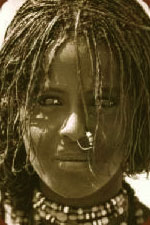Nose Jeweling...Thoughts?
- McQueen Media

- Nov 2, 2018
- 4 min read
I woke up a few mornings ago with the urge to have my nose pierced, so I decided to do some research. Nose piercing is spoken of in the bible...most notably in the Proverbs 11:22 saying,
" Like a gold ring in a pig’s snout is a beautiful woman who shows no discretion."

Of course this speaks of a pig's snout being pierced versus a human's nose, but the context in which it is used is applicable to LIFE, especially for Women...take heed. Nose rings are also noted as gifts Abraham gave his daughter-in-law(s). Either way, it's always attributed as being a beautiful thing. Below, you'll find some history of Nose piercing that I found...I'll be back to give my conclusions soon! lol
The nose is the face's most prominent feature; as Leonardo Da Vinci said, it sets the character for the whole face.
It's no surprise then that a nose piercing can positively accentuate one's face, making nostril piercings in particular a very attractive type of piercing on many people.
The history of nose piercing dates back to ancient times; it was first recorded in the Middle East approximately 4,000 years ago. It's also mentioned in The Bible in Genesis 24:22, where it's recorded that Abraham asked his oldest servant to find a wife for his son, Isaac. The servant found Rebekah, and one of the gifts he gave her was a "golden earring". The original Hebrew word used was Shanf, which translates to "nose ring".
The practice of nose piercing is still followed among the nomadic Berber and Beja tribes of Africa and the Bedouins of the Middle East. The size of the ring gifted denotes a family's wealth. It's given by a husband to his wife when they marry, and it represents financial security for her in the event that she and her husband are divorced.
In the 16th century, nose piercing was brought to India from the Middle East by the Mughal emperors. In India, a stud (called a "Phul") or a ring (i.e. "Nath") is usually worn in the left nostril, although both nostrils are pierced in some areas. The reason the left nostril is more commonly pierced is due to that spot being associated with female reproductive organs in Ayurveda (i.e. Indian medicine); the piercing is supposed to make childbirth easier and lessen period pain. An Indian woman's nose piercing is sometimes joined to her ear by a chain.
In the west, nose piercing first appeared among the hippies who had traveled to India in the Late 1960s. In the 1970s, the practice of nose piercing was adopted by the Punk movement as a symbol of rebellion against conservative values. Conservative people--particularly parents and employers--still don't react well to it, so consider any reactions that could negatively affect you or your career carefully before having your nose pierced.
Nowadays, nose piercing is gradually becoming more socially acceptable. Many celebrities have their noses pierced--for instance, Madonna, Lenny Kravitz, Sinead O'Connor, and Slash from Guns & Roses. More and more, you'll see everyday people sporting little gem-topped nostril studs and fine hoops, too, including professionals in a variety of settings ranging from retail outlets to doctor's offices.

Septum piercing History
Septum piercing is probably the second most common type of piercing among primitive peoples after ear piercing; it's even more common than nostril piercing. The practice of septum piercing is likely as popular as it is for the same reasons as nostril piercing, with the added attraction that the piercing can be stretched so that large pieces of jewellery can be inserted--for instance, pigs' tusks, pieces of bone, feathers, pieces of wood, and other natural materials.
Septum piercing is particularly prevalent among warrior cultures, most likely due to the fact that a warrior with a large tusk through the septum looks especially fierce. The use of septum tusks is very prevalent in Irian Jaya, New Guinea and the Solomon Islands, with pigs' tusks being the most popular material used as septum jewelry. Among the Asmat tribe of Irian Jaya, the most prestigious septum tusk is the "Otsj", which is a large bone plug that can be as thick as 25mm in diameter. Otsj are usually made from the leg bones of pigs, but occasionally they are made from the tibia bones of enemies slain in battle.

Septum piercings were a beloved tradition of the Aztecs, Maya and Incas in particular. They wore a variety of jewelry in their pierced septums, but jade and gold were the most popular materials because of their religious connotations. The modern day Kuna Indians of Panama continue this practice by wearing thick, pure gold rings in their septums.
This type of piercing is also popular in India, Nepal, and Tibet, where a pendant "Bulak" is worn. Some septum jewelry found in these cultures is so large that it prevents the wearer from being able to eat without manually lifting the jewelry during meals. In Rajasthan in Himachal Pradesh, Bulak are particularly elaborate and extremely large.
Septum piercing was widely practiced by many North American Indian tribes. The name of the Nez Perc tribe of Washington state stems from their practice of piercing the septum. "Nez Perc" is French for "nose pierced", and it was given to the tribe by French fur traders.
Australian aboriginals pierced the septum with the goal of flattening the nose. They passed a long stick or bone through the piercing to achieve the desired effect because they believed a flat nose to be the most desirable-looking.
The age at which septum piercing is done varies greatly between different tribes. Among the Bundi tribe of the Bismarck Ranges of Papua, New Guinea, septum piercing is performed using the thin end of a sweet potato plant ("Ogai Iriva"), usually between the ages of 18 and 22.3 However, some tribes perform the rite on children as young as age 9-10.

"You were lost in the bush and now you have come back. You have come back mature; you are men. When you return to your hamlet many girls will come after you. But if you have lived well, and if they come after you, all the well. You will now have your noses pierced to allow you to sing with girls and lead a life like that of your elders. Your (Kangi Poroi) caused you to go to all this trouble, now it will be over."
Source: https://info.painfulpleasures.com/help-center/piercing-information/history-body-piercings













Comments